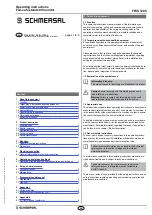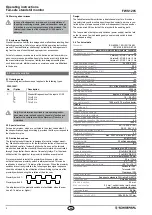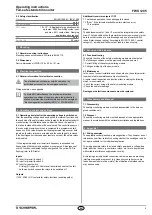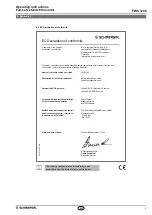
2
Operating instructions
Fail-safe standstill monitor
FWS 1205
EN
1.6 Warning about misuse
In case of inadequate or improper use or manipulations of
the safety-monitoring module, personal hazards or damage
to machinery or plant components cannot be excluded. The
relevant requirements of the standard EN 1088 must be
observed.
1.7 Exclusion of liability
We shall accept no liability for damages and malfunctions resulting from
defective mounting or failure to comply with this operating instructions
manual. The manufacturer shall accept no liability for damages result-
ing from the use of unauthorised spare parts or accessories.
For safety reasons, invasive work on the device as well as arbitrary re-
pairs, conversions and modifications to the device are strictly forbidden;
the manufacturer shall accept no liability for damages resulting from
such invasive work, arbitrary repairs, conversions and/or modifications
to the device.
2. Product description
2.1 Ordering code
This operating instructions manual applies to the following types:
FWS 1205
➀
No.
Option
Description
➀
Standstill frequencies of the inputs X1/X2:
A
1 Hz/2 Hz
B
2 Hz/2 Hz
C
1 Hz/1 Hz
Only if the information described in this operating instruc-
tions manual are realised correctly, the safety function and
therefore the compliance with the Machinery Directive is
maintained.
2.2 Special versions
For special versions, which are not listed in the order code below 2.1,
these specifications apply accordingly, provided that they correspond to
the standard version.
2.3 Destination and use
The fail-safe standstill monitor is designed for control cabinet mount-
ing. Standstill monitors serve for the fail-safe detection of the machine
standstill and control of solenoid interlocks. As soon as the fail-safe
monitor has detected the standstill, the solenoid interlock is controlled
through the potential-free contacts of two safety relays. For the stand-
still detection, the signals of two proximity switches are evaluated.
It is recommended to install the proximity switches on a disc cam
so that at least one proximity switch is always actuated. This can be
realised by a minimum 1:1 division of the disc cam. When the proximity
switches are correctly installed, the following unique signal sequence
should be obtained by the utilisation of the switching hysteresis of the
proximity switches during the rotation of the disc cam.
Proximity switch 1:
Proximity switch 2:
The adjustment of the proximity switches is facilitated, when the cam
has a 2:1 division (or higher).
Design
The fail-safe standstill monitor has a dual-channel structure. It includes
two safety relays with monitored positive guided contacts, which are con-
trolled by two microprocessors, which are independent from one another.
The series-wired NO contacts of the relays build the enabling path.
The feed cables of both proximity switches (power supply) must be laid
so that in case of a wire breakage only one proximity switch is dead
(star-shaped routing).
2.4 Technical data
Standards:
EN 60204-1, EN ISO 13849-1,
IEC 61508, BG-GS-ET-20
Enclosure:
glass-fibre reinforced thermoplastic, ventilated
Feedback circuit (Y/N):
no
Standstill frequency:
Version A: X1/X2: 1 Hz / 2 Hz
Version B: X1/X2: 2 Hz / 2 Hz
Version C: X1/X2: 1 Hz / 1 Hz
Rated operating voltage U
e
:
24 VDC ± 15%
Rated operating current I
e
:
0.2 A
Rated insulation voltage U
i
:
250 V
Internal electronic protection (Y/N):
no
Power consumption:
< 5 W
Inputs monitoring:
Short-circuit recognition:
no
Wire breakage detection:
yes
Earth connection detection:
yes
Hysteresis:
10% of the standstill frequency
Max. input frequency:
4000 Hz
Min. impulse duration:
125 μs
Input resistance:
approx. 4 kΩ against GND
Input signal „1“:
10 ... 30 VDC
Input signal „0“:
0 ... 2 VDC
Max. cable length:
1000 m of 0.75 mm² conductor
Outputs:
Stop category 0:
2
Stop category 1:
0
Number of safety contacts:
2
Number of auxiliary contacts:
0
Number of signalling outputs:
2
Max. switching capacity of the safety contacts:
6 A
Required short-circuit current:
1000 A
Utilisation category to EN 60947-5-1:
AC-15: 230 V / 3 A;
DC-13: 24 V / 2 A
Rated impulse withstand voltage U
imp
:
4 kV
Thermal test current I
the
:
6 A
Contact load capacity:
max. 250 VAC, max. 6 A (cos φ=1)
Max. fuse rating:
6 A gG D-fuse
Mechanical life:
20 million operations
LED display
:
ISD
Ambient conditions:
EMC rating:
conforming to EMC Directive
Overvoltage category:
III to DIN VDE 0110
Degree of pollution:
2 to DIN VDE 0110
Resistance to vibration:
10 ... 55 Hz / amplitude 0.35 mm
Resistance to shock:
30 g / 11 ms
Environmental temperature:
0 °C …+55 °C
Storage and transport temperature:
−25 °C…+70 °C
Protection class:
Enclosure: IP40,
Terminals: IP20,
Clearance: IP54
Degree of pollution:
2
Mounting:
Snaps onto standard DIN rail to EN 60715
Connection type:
Screw connection
Min. cable section:
0.2 mm²
Max. cable section:
2.5 mm², solid strand or multi-strand
lead (including conductor ferrules)
Tightening torque:
0,6 Nm
Weight:
190 g
Dimensions (H x W x D):
100 x 22.5 x 121 mm
























